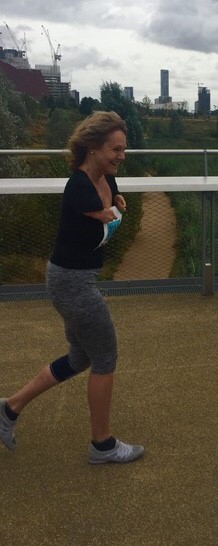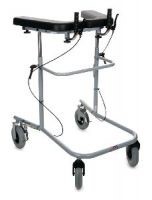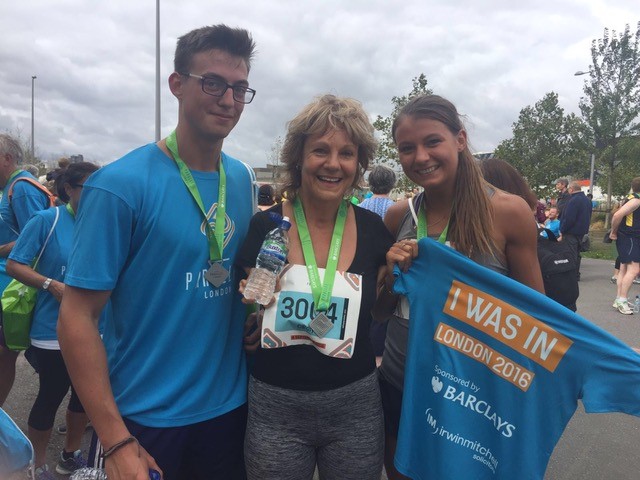Managing My Hip Replacement
 Carolyn shares her successful experience of managing and planning her hip replacement operation and recovery
Carolyn shares her successful experience of managing and planning her hip replacement operation and recovery
Four years ago I found myself needing a hip replacement. After several years of pain, which affected me especially at night when lying down, I decided I did need to go ahead with the operation. My consultant Mr Andrew Manketlow and his team from Nottingham University Hosptitals were key in making the experience as smooth as possible enabling me to recover in the shortest possible time.
As soon as I heard that I would need a total hip replacement, I contacted The Thalidomide Trust for support. I was put in touch with other beneficiaries who had undergone the operation. I made sure I wrote down recommendations to talk through with my consultant.

As I have upper limb damage and use my legs a lot in daily life, it was important for me to talk through in detail a number of things so the team understood the special considerations. In particular:
How I use my legs - i.e. To brush my hair, pick up objects, wiping kitchen surfaces etc. I really needed to be able to continue to so
these things after the operation.
What support I would need while in hospital - i.e. Help with washing/ dressing/ toileting, reaching the call button etc
What care and support I would need after discharge from hospital
What equipment I would need (and be able to use) for rehab
My consultant used my discussion points to plan the type of hip I would require. He used the largest hip "ball" possible as it was the least likely to dislocate when I used my leg as before. He also organised pre-operative assessment from both physiotherapy and occupational therapy.
The Physiotherapy team supplied me with 2 "pulpit" frames One to use initially in hospital then another to take home, to use one upstairs and one down. I am quite tall but the frames, on wheels, had a padded frame that could be raised to my chest height. I could lean against this meaning I could walk forward with most of my weight on my chest, with little weight on my operated leg.
 We also decided that I would need underarm crutches as I would not be able to manage more modern crutches - the physio dept found the last pair in the hospital to lend me!
We also decided that I would need underarm crutches as I would not be able to manage more modern crutches - the physio dept found the last pair in the hospital to lend me!
Occupational Therapy visited me at home to note bed height, toilet height, seating, shower access etc. They arranged for the Red Cross to deliver a high straight backed chair (this ensured I could get out of a chair keeping my body and legs in no less than the 90 degree angle recommended to reduce risk is dislocation), a height adjustable table on wheels that could be moved to my chair / bed etc, a commode in case I could not get to the toilets, a shower stool, and they fitted raised toilet seats to en suite and downstairs loos.
I was all ready – so how did it go?
Day 1 Operation day!
It had been an eventful build up to the operation. My initial operation date was postponed as my father passed away quite suddenly, and the second date changed due to hospital bed shortages. At pre-operation assessment, it had been decided I would have a spinal, rather than a general anaesthetic. The numbness in legs after the operation, mean that pain is reduced for a few hours longer than with a general anaesthetic. I had forgotten to discuss my difficulties fitting the canular however.... A poor student doctor tried to fit the canular in my cold right foot, he was also asked to give his first spinal anaesthetic! The experience has since made me request at a recent knee operation, that a student does NOT fit my canular, although I think the anaesthetist had equal difficulties! As it was not a general anaesthetic, I also requested that I was not "fully aware" during the operation. I was sedated with something very relaxing, so that although I was aware of the latter half of the operation, I felt comfortable and very happy!
Days 2 - 5
I was placed on a very busy orthopaedic ward. I think my extra needs did put extra pressure on the ward staff, but they were generally very helpful. They made sure I could reach the call button. I could move myself up and down the bed as the spinal wore off, with my good leg. I was visited by physiotherapy on the first afternoon, but I was very sleepy and they actually delayed getting me out of bed until day 3. The hardest thing about getting out of bed was needing help to lower the operated leg to the ground, but once the leg was down, I could move on the pulpit frame at first slowly, but then built up ability to move further. The physio trained my husband how to help me up the stairs. I used an underarm crutch on one side and my husband held me on the second. We managed okay and only got a little " tetchy" with one another! I was discharged on day 5. It was quite nerve racking, especially getting in a car. Luckily Rob, my husband has a 4x4 which meant the car seat level was a good height which made it easier.
Week 1 at home
The first few days were painful and tough on the whole family I think. I needed help with everything from all toileting, washing, and moving up and down stairs. I had to wear elastic long socks to prevent blood clots, and these were really hard for my partner to put on. I think if I needed another operation like this, I would arrange for a carer to come in to help me get up, showered and dressed for the first couple of weeks. This would lessen the strain on family members. A district nurse came in each day to give me the necessary daily injection, again to prevent blood clotting. I was very determined to get better and reliably did my physiotherapy exercises 3 times a day.
Weeks 2 - 6
I gradually became able to move more easily and also found different ways of doing things. I began to do short walks outside to build up my strength and confidence. I had a physiotherapy appointment at hospital at the beginning of week 3, and we were able to take back one pulpit frame as I could move around upstairs just on crutches. The crutches did hurt me under my arms, but I padded them up with a small towel, which helped! I was determined to walk albeit slowly, half a mile before I returned to work. I was allowed to drive after 6 weeks. I did find it hard to reach the hand brake / drive/reverse lever, as it was too stiff to lean towards the levers, but I soon found a way of doing this with my good leg.
8 Weeks Post-Op
I returned to work - but did have a week’s holiday planned a short time after in Majorca. I am sure, the warmth, swimming and walking on sandy beaches helped my strength and movement even more.
Today
 4 and a half years on, I feel the operation has been a huge success. I have been pain free and although my flexibility is reduced on that side ( I can't brush my hair with my right foot, I can no longer cut my toe nails, or put on nail polish), the benefits outweigh these difficulties. Unfortunately I now have issues with my left knee, wear and tear will mean a further operation in the future, but I do feel more prepared.
4 and a half years on, I feel the operation has been a huge success. I have been pain free and although my flexibility is reduced on that side ( I can't brush my hair with my right foot, I can no longer cut my toe nails, or put on nail polish), the benefits outweigh these difficulties. Unfortunately I now have issues with my left knee, wear and tear will mean a further operation in the future, but I do feel more prepared.
My Advice
If, unfortunately, you find yourself having to undertake such an operation, I do recommend the following:-
- take time to really plan what you will need when unable to use your legs.
- if you are nervous about talking to doctors, write things down and take a friend, partner or advocate with you to ensure you are understood.
- I think access to a local rehab team is really important. We were lucky in Nottingham with a team who was able to give me the time. I think that services have been reduced in the last few years so if I need another operation, I may need to arrange some private support if necessary
- make sure you have your care at home set up well. It is better to plan too much and not need it than to plan too little care.
- it was a difficult, painful experience but certainly the results have been worth it. However, be prepared, you might not be able to do things in the same way as you did prior to the operation.
